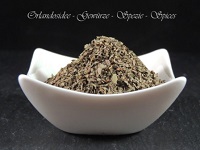
Wild Basil
Ocimum basilicum — sweet, fresh, lightly aniseed
Wild basil is a Mediterranean classic with a bright, sweet-herbal perfume and a light anise/licorice lift. Dried leaves are convenient for sauces and rubs, while fresh basil is the star for pesto and tomato salads.
- Botany: Ocimum basilicum • Family: Lamiaceae
- Parts used: leaves (dried)
- Profile: sweet-herbal, green, gently peppery; light anise notes
- Best for: tomato dishes, pesto-style sauces, salads, fish, chicken, vegetables
Aroma & Taste
Sweet-green and floral with a cool anise echo. Dried basil is subtler than fresh but stands up better to heat; add a final pinch off-heat for freshness.
Culinary Uses
- Tomatoes & mozzarella: finish salads and bruschette with a light sprinkle.
- Sauces: stir into tomato sauce near the end; fold into cream or butter sauces for fish.
- Pesto-style: dried basil can boost color/aroma in cooked pesto sauces (fresh is preferable for classic raw pesto).
- Poultry & fish: combine with lemon, garlic and olive oil for marinades or quick pan sauces.
- Vegetables & grains: zucchini, eggplant, peas, potatoes, rice and couscous salads.
How to Use
- Timing: add dried basil in the last 5–10 minutes of cooking; finish with a pinch off-heat.
- Crush to release aroma: rub dried leaves between fingers just before adding.
- Fresh ↔ dried: rule of 3 — 1 tsp dried ≈ 1 Tbsp fresh.
Dosage & Kitchen Ratios
- Sauces/soups: 1–2 tsp dried per 1 l (4 cups) base.
- Rubs/marinades: 1–2 tsp dried per 500 g (1.1 lb) protein or veg.
- Dressings: 1/4–1/2 tsp dried per 250 ml (1 cup) vinaigrette.
Pairings
Tomato, garlic, lemon zest/juice, olive oil, oregano, thyme, parsley, pine nuts, Parmesan; chicken, white fish, prawns; vegetables like zucchini, eggplant, peas and potatoes.
Ingredients & Allergens
Ingredients: Wild basil leaves (Ocimum basilicum).
Allergens: none mandatory in EN labeling for this single ingredient.
Storage & Shelf Life
Store airtight, cool, dry and away from light. Best aroma within 12–18 months. Reseal promptly after use.
Substitutes & Notes
Closest swaps: marjoram or oregano (use slightly less oregano). For pesto, fresh basil remains essential; dried basil can support cooked sauces.
FAQ
Can I use dried basil for pesto?
Classic pesto uses fresh leaves; dried basil can season cooked “pesto-style” sauces but won’t deliver the same freshness.
When should I add basil to tomato sauce?
In the last 5–10 minutes, then finish with a small pinch off-heat for vivid aroma.
How much dried basil equals fresh?
About 1 tsp dried = 1 Tbsp fresh (3× by volume).
Merchant contact: Orlandosidee — Spice Shop (see site imprint for full company details). Email: info(at)orlandosidee.de



